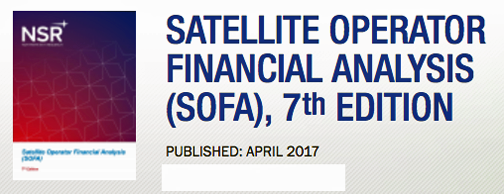 NSR’s Satellite Operator Financial Analysis, 7th Edition, just released, finds in an industry fraught with falling prices and indebted behemoths, satellite operators who are now playing a more aggressive game to find and stimulate growth.
NSR’s Satellite Operator Financial Analysis, 7th Edition, just released, finds in an industry fraught with falling prices and indebted behemoths, satellite operators who are now playing a more aggressive game to find and stimulate growth.
A shift in emphasis, away from the broadcast-dominated days, into a brave new world of HTS, LEOs and MEOs, with radical and sometimes risky changes that are expected to move operator financials forward.
In 2016, top-line operator revenues declined in USD terms by just under three percent, as the Euro-Dollar exchange rate stabilized and emerging market currencies, such as the Brazilian Real, rebounded. (The latter event lead to Star One posting a sizzling 46 percent USD-denominated revenue growth rate.) A continued downward momentum of revenues per transponder continued as data markets suffered and several operators saw their cash piles wind down due to acquisition or paying down debt.
To counter the stagnation of traditional capacity business, operators are making big, potentially risky plays. These moves have been prominent last year and so far in 2017. This shows most clearly in SES’s financials—the company’s EBITDA margin dropped from 74.2 to 70.2 percent (though 73.7 percent using same scope noted Blaine Curcio, Principal Analyst at NSR and report co-author. “This was a result of the company making a big bet by acquiring full ownership of O3b, and a less publicized, but perhaps as important move in acquiring RR Media. For an industry that has long-prized its sky-high EBITDA margins, this was quite a bold statement,” he said.
Other noteworthy examples of operators upping the ante include Intelsat and OneWeb’s proposed merger, Telesat’s potential LEO-HTS play, and the proposed GEO-HTS mobility constellation spearheaded by Hong Kong-based APT Satellite through a Mainland Chinese Joint Venture. Conspicuously absent from the table is Eutelsat, with the company sticking to its guns of high-margin video hotspots and broadband, with the strategic implications of all the above developments and more discussed within the study.
”2016 also saw operators becoming more competitive in their respective international data/mobility markets, with heavy discounts on bulk contracts for customer acquisition. This was well complemented with an emphasis on curbing CAPEX and OPEX to offset pressure on top line revenues, and, more importantly, checking their debt profiles with majority of them undertaking partial or full debt refinancing,” noted Gagan Agrawal, Analyst at NSR and a report co-author. “This cost savings trend is expected to continue, giving leeway to operators to manage their cash flow better and hedge against lower EBITDA margins arising from service oriented businesses un-commoditizing capacity, which itself became necessary due to downward pricing pressures in data and mobility markets. It’s truly a paradigm shift, as satellite operators look for growth in other parts of media and connectivity value chains."

